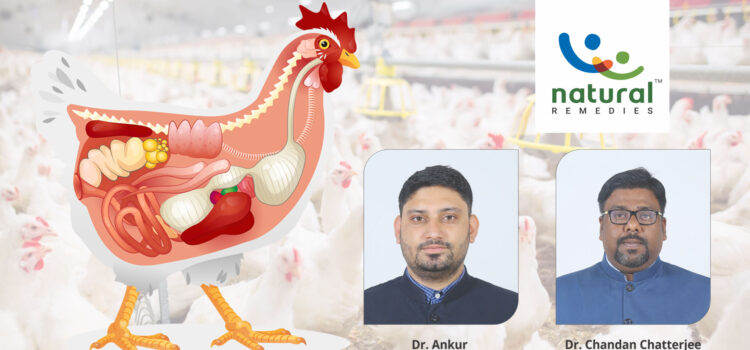Folliculogenesis is the development or maturation of the ovarian follicle which is densely packed somatic cells that contains an immature oocyte. This process outlines the succession of several small primordial follicles into large pre-ovulatory follicles which occurs in stages during the ovulatory cycle. Follicle development in the laying hen is characterized by a well-organized hierarchy (Fig 1).
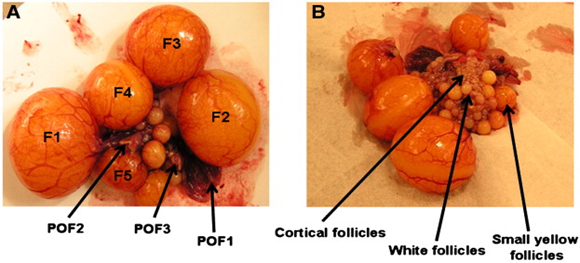
However, follicular hierarchy is not observed in birds with lower reproductive efficiency. In case of chicken, left ovary is functional both physiologically and anatomically. The right ovary is present during embryogenesis, but the distribution of primordial germ cells to the ovaries of the chicken becomes asymmetrical by day 4 of incubation and starts regression by day 10 of the incubation. The ovary of immature birds consists nearly 2000 small ovas but only 200-500 reach maturity and are ovulated with in the production period.
Growth of Follicles:
The single left ovary contains follicles of various sizes and developmental stages including cortical primordial follicles, white follicles and large yolk-filled follicles (Fig 1) that have recruited to the well-ordered preovulatory hierarchy.
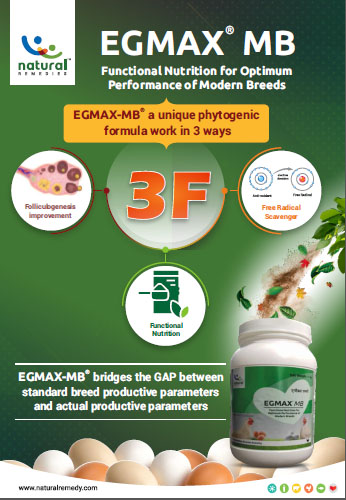
Growth from 3 to 5 mm takes 3 days, from 5 to 8 mm 2 days and from 8 mm to ovulation (40 mm) 6 days (Gilbert et al. 1983), with the total time for development from 1·5 mm to 40 mm being around 17 days (Perry et al. 1983). Yolk formation occurs in the liver and is triggered by gonadotropin and steroid hormones. A diagrammatic sequence of vitellogenesis in the hen is presented in Fig 2. The yolk protein precursor, vitellogenin, is transported through the blood to the ovary, where it is cleaved into the two yolk proteins, lipovitellin and phosvitin (Deely et al., 1975). Triglycerides are transported to the yolk in the form of β- lipoproteins and later are assimilate into the yolk as lipid globules. Lipids and protein are deposited into the premature follicle withequal proportion for most of the growth phase, but during the final rapid growth phase, relatively more lipid is incorporated. The final composition of yolk in the hen’s egg consists of a greater percentage of lipid (33% of wet weight) compared to protein (16% wet weight).
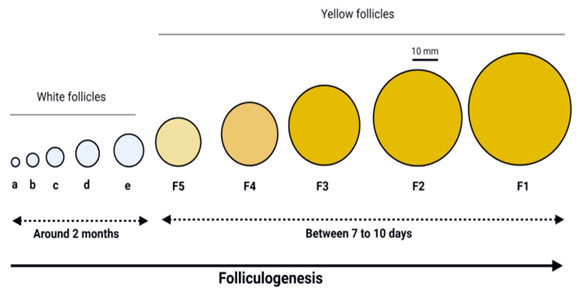
Hormonal regulation for follicle development
Follicle stimulating hormone (FSH) in the hen is responsible for the selection and granulosa cell development of the small follicles.FSH acts mainly on the granulosa layer of the tiny yellow and sixth (F6) to third (F3) largest follicles. It is also stimulating progesterone production in granulosa cells from F6 to F3 follicles. The Luteinizing hormone (LH) in hens does not luteinize the follicles, however it involved in ovulation and steriodogenesis. The primary target for the LH is larger preovulatory follicles (Fig 3).
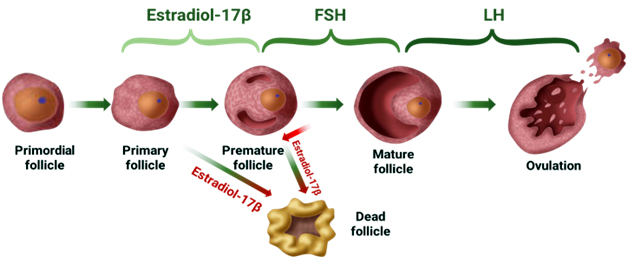
Relationship between folliculogenesis and egg production
The broiler breed of different breeder (Table 1) is performing less in actual compared to breed specific standard which creates a significant gap between actual performance and breed specific standard. There are several challenging factors that make it difficult to bridge this gap.
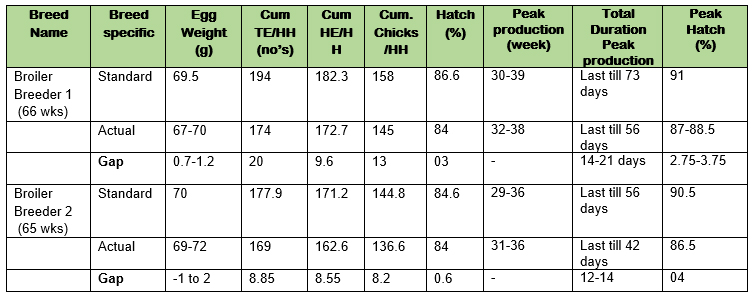
This may be due to visible factors like climate, pathogens, nutrition, and management which are completely under the control of poultry entrepreneur. These factors play important role to breeder hen performance and are major key elements for successful broiler breeder farming. However, the foundation of these factors is completely depends on hidden factors like inadequate functioning of hormones and cell damage due to oxidative stress (Fig 4).
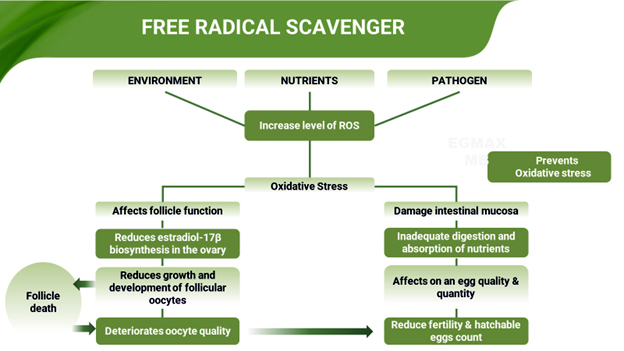
Why to lose even a single number
EGMAX®MB a product from Natural Remedies® have a property to reduce the intracellular ROS. The key Phyto-constituents of this product are Phyto-lactones, Phyto-saponins and Terpenoids. EGMAX®MB works in laying hen with 3F:
A) Folliculogenesis improvement: EGMAX®MB increases the activity of GnRH secreting neurons/cells at Hypothalamus which in turn enhances Folliculogenisis through better LH & FSH levels at Pituitary gland. It also Enhances secretion of estrogen hormone from ovary thereby induces folliculogenesis. The study shows that EGMAX MB has shown a significantly increase in total follicle count, serum FSH & LH levels as compared to control. (Fig 5).
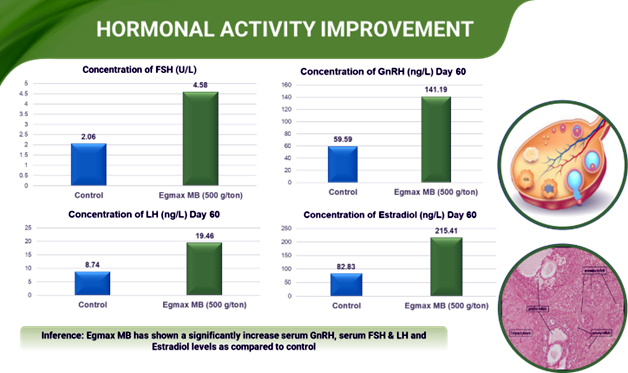
B): Free radical scavenger: The active ingredients of Egmax®MB reduces the level of reactive oxygen species (ROS) and in-turn reduces oxidative stress in ovarian follicles and prevents the follicle cell death. The healthy ovarian cells are necessary for produces estrogen hormone.
C): Functional nutrition: The active ingredients of Egmax®MB nourishes ovary and rejuvenates its functions by promoting growth and development of ovarian follicles, enhances ovulation and revitalizes the female reproductive system.
Field Trial of EGMAX- MB in different Broiler Breeder breeds
Trial 1: A trial was conducted in the month of Jan 2021 to test efficacy of Egmax®MB in Broiler breed 1 aged 41 weeks and concluded that Supplementation of Egmax®MB at 500 g/ton resulted in Egmax MB treated group has increased HDEP %, reduced feed intake per egg (g) and increased hatchable egg as compared to standard (Table 2-4).
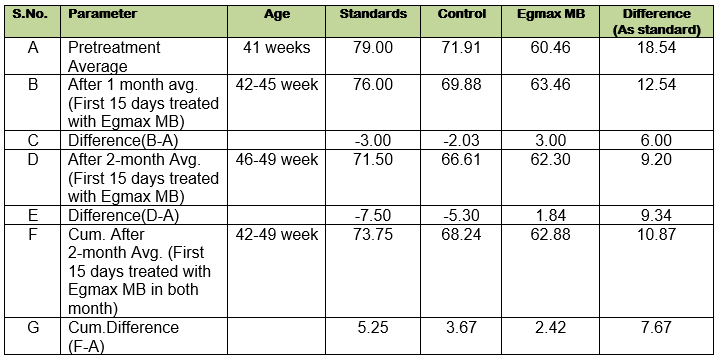
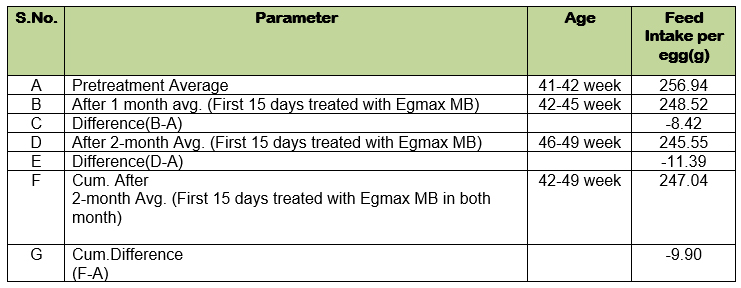
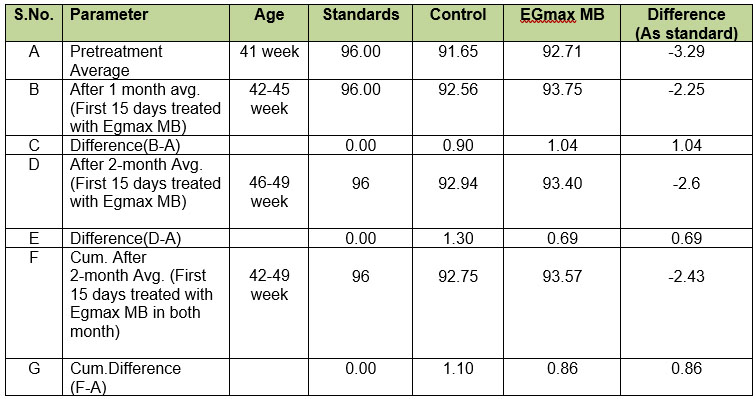
Conclusion:
✔ EGMAX MB helps to reduce the gap between Standard productive parameters vs actual productive parameters.
✔ EGMAX MB helps to enhance quality and quantity of hatching eggs
✔ EGMAX MB improves fertility and hatchability
✔ EGMAX MB aids in optimizing egg production.
✔ Phyto-constituents in EGMAX MB act as functional nutrition to improve overall productivity and profitability of breeder hens.
Authors:
Dr. Ankur, Product Manager, Natural Remedies
Dr. Chandan Chatterjee, Marketing Manager, Natural Remedies
References: Stifani, S., Nimpf, J. and Schneider, W.J., 1990.Vitellogenesis in Xenopuslaevis and chicken: cognate ligands and oocyte receptors. The binding site for vitellogenin is located on lipovitellin I. Journal of Biological Chemistry, 265(2), pp.882-888. Sullivan, C.V. and Yilmaz, O., 2018. Vitellogenesis and yolk proteins, fish. Encycl. Reprod.2nd edn.Elsevier. Bacon, W.L. and Skala, J.H., 1968. Ovarian follicular growth and maturation in laying hens and the relation to egg quality. Poultry Science, 47(5), pp.1437-1442. Lovell, T.M., Gladwell, R.T., Groome, N.P. and Knight, P.G., 2003. Ovarian follicle development in the laying hen is accompanied by divergent changes in inhibinA, inhibin B, activin A and follistatin production in granulosa and theca layers. Journal of Endocrinology, 177(1), pp.45-56. Gilbert AB, Perry MM, WaddingtonD&Hardie MA 1983 Role of atresia in establishing the follicular hierarchy in the ovary of the domestic hen (Gallus domesticus). Journal of Reproduction and Fertility 69 221–227. Perry MM, Waddington D, Gilbert AB &Hardie MA 1983 Growth rates of the small yolky follicles in the ovary of the domestic fowl. IRCS Medical Science 11 979–980. Deeley, R.G., Mullinix, D.P., Wetekam, W.A.L.D.E.M.A.R., Kronenberg, H.M., Meyers, M., Eldridge, J.D. and Goldberger, R.F., 1975.Vitellogenin synthesis in the avian liver.Vitellogenin is the precursor of the egg yolk phosphoproteins. Journal of Biological Chemistry, 250(23), pp.9060-9066.



